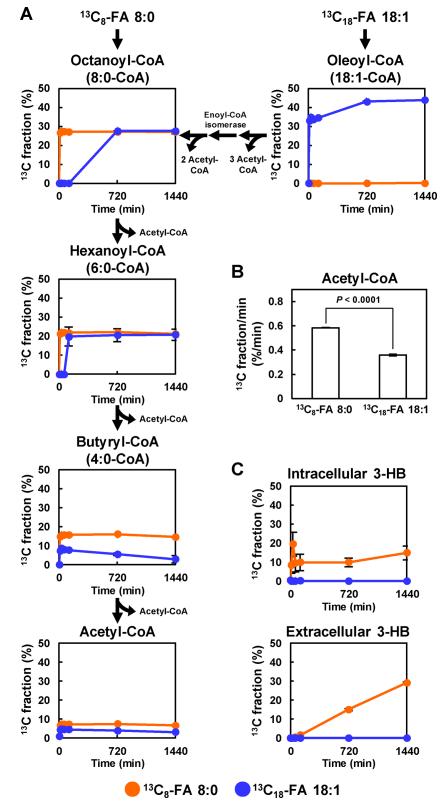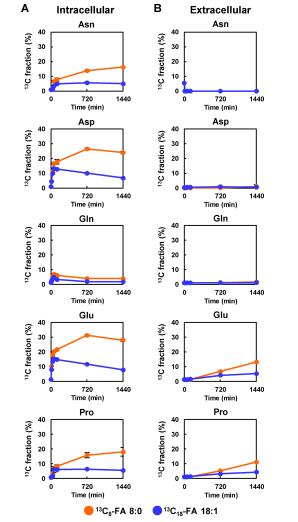Medium-Chain Fatty Acids Analysis Service
Submit Your Inquiry- Service Details
- Case Study
What is Medium-Chain Fatty Acids?
Medium-Chain Fatty Acids, often abbreviated as MCFAs, constitute a distinctive class of saturated fatty acids characterized by relatively shorter carbon chains, typically ranging from 6 to 12 carbon atoms. These unique fatty acids are noteworthy for their rapid metabolism, making them stand out from their long-chain counterparts. MCFAs are naturally found in select food sources, including coconut oil and certain dairy products. These compounds are recognized for their rapid absorption and efficient conversion into energy within the liver. This particular metabolic behavior positions MCFAs as an intriguing subject of scientific exploration with wide-ranging implications for nutrition, metabolism, and health.
The analysis of MCFAs is indispensable due to several compelling reasons. Foremost, MCFAs occupy a pivotal role in dietary and nutritional studies. Their presence and quantity in various dietary sources necessitate thorough examination for the formulation of dietary guidelines and the optimization of health management strategies.
Moreover, industries such as biomedicine and pharmaceuticals require precise and meticulous MCFA measurements for the development of an array of products. These applications span from drug formulations to nutritional supplements. In the context of pharmaceuticals, precision is paramount to ensure product quality and therapeutic effectiveness.
In essence, understanding and quantifying MCFAs through rigorous analysis is essential for both the advancement of scientific knowledge and the practical application of this knowledge in diverse industries.
Creative Proteomics is well-equipped to meet these analytical needs through our comprehensive Medium-Chain Fatty Acids analysis services, carried out with state-of-the-art technology and expertise.
Medium-Chain Fatty Acids Analysis Services Offered by Creative Proteomics
We offer a wide range of specialized Medium-Chain Fatty Acids (MCFAs) analysis services designed to meet the diverse needs of researchers, dietary experts, pharmaceutical companies, and various industries. Here are the specific services we provide:
Quantitative Analysis of Medium-Chain Fatty Acids:
- Accurate quantification of various Medium-Chain Fatty Acids, including Caproic acid (C6:0), Caprylic acid (C8:0), Capric acid (C10:0), Lauric acid (C12:0), and more.
- Quantitative analysis to determine the concentration of MCFAs in different samples.
Qualitative Analysis of Medium-Chain Fatty Acids:
- Verification of the presence of Medium-Chain Fatty Acids to support research and industrial applications.
- Identification of specific MCFAs types and relative content.
Medium-Chain Fatty Acids Analysis in Food Products:
Analysis of MCFAs in food products such as coconut oil and dairy products for nutrition assessment and product quality control.
Medium-Chain Fatty Acids Analysis in Pharmaceutical Development:
Support for pharmaceutical companies in drug formulation and quality control to ensure product stability and efficacy.
Medium-Chain Fatty Acids Analysis in Biomedical Research:
Use of MCFA analysis in research to explore their role in metabolic disorders, health issues, and disease prevention.
Medium-Chain Fatty Acids Analysis in Agriculture and Food Industries:
Assessment of the nutritional content in food products, including dairy and coconut-based products.
Medium-Chain Fatty Acids Analysis in Biotechnology:
Utilization of MCFAs in biotechnological processes, including the production of biofuels.
Medium-Chain Fatty Acids Analytical Techniques
Creative Proteomics employs state-of-the-art mass spectrometry-based techniques to ensure the precision and reliability of our MCFAs analysis. The following are the instrumental techniques and models we utilize:
Gas Chromatography-Mass Spectrometry (GC-MS): We utilize the Agilent 7890A Gas Chromatograph combined with the Agilent 5975C Mass Spectrometer. This robust pairing is renowned for its ability to achieve exceptional separation and quantification of MCFAs, ensuring both high throughput and precision. The Agilent 7890A and 5975C systems enjoy widespread recognition in the industry for their unmatched reliability and accuracy.
Gas Chromatography with Flame Ionization Detection (GC-FID): Our GC-FID analysis is performed using the Agilent 7890B Gas Chromatograph, featuring a Flame Ionization Detector. This configuration enables us to achieve highly sensitive and specific detection of MCFAs, making it an invaluable tool for our analysis. GC-FID is particularly well-suited for the meticulous examination of trace-level MCFAs.
Liquid Chromatography-Mass Spectrometry (LC-MS): Our LC-MS analysis relies on the state-of-the-art Thermo Fisher Scientific Q Exactive series. This cutting-edge LC-MS platform is celebrated for its exceptional sensitivity and specificity, empowering us to precisely identify and quantify MCFAs. The Q Exactive series is highly regarded for its advanced technology, rendering it an invaluable asset for our analytical processes.
List of Analyzed Medium-Chain Fatty Acids, including but not limited to
Creative Proteomics offers comprehensive limonene analysis services, not limited to D-limonene but extending to various limonene derivatives and isomers. Here is a list of some limonene variants we can analyze:
| Type | Specific Substance |
|---|---|
| Saturated MCFAs | Caproic acid, Caprylic acid, Capric acid, Lauric acid, Myristic acid |
| Unsaturated MCFAs | Caproleic acid, Caprinic acid, Lauricoleic acid, Myristoleic acid |
| Branched-Chain MCFAs | 2-Methylbutyric acid, 2-Methylpentanoic acid, 2-Methylhexanoic acid, 2-Methylheptanoic acid |
Sample Requirements for Medium-Chain Fatty Acids Assay
| Sample Type | Sample Amount | Sample State | Special Handling Requirements |
|---|---|---|---|
| Serum/plasma samples | 0.5-1 mL (or as required) | Frozen (if necessary) | Collect samples in suitable anticoagulant tubes, process and freeze promptly. Ensure proper labeling and documentation. |
| Biological samples (e.g., animal tissues) | As required | Fresh, frozen, or lyophilized | - Fresh samples: Keep samples on ice during transport and homogenize immediately upon receipt. - Frozen samples: Store at -80°C in airtight containers, avoiding freeze-thaw cycles. - Lyophilized samples: Ensure proper sealing to prevent moisture absorption. - Homogenization may be necessary, using suitable solvents. |
| Liquid samples (e.g., coconut oil, dairy oil) | 1-2 mL (or as required) | Clear, non-turbid, and homogenous | Transfer samples to amber glass vials with Teflon-lined caps to protect against oxidation and store away from light. |
| Solid samples (e.g., powdered food products) | 0.5-1 g (or as required) | Ground into a fine powder | Grind samples into a fine, uniform powder using a suitable homogenizer. Freeze-drying might be necessary for certain products. |
| Food products (e.g., dairy items) | As required | Dependent on product form | Consult our guidelines for specific preparation steps based on the particular product composition and state. |
| Environmental samples (e.g., soil) | As required | Fresh or preserved as specified | Follow our guidelines for sample collection and preservation based on the environmental matrix and research objectives. |
If you would like to analyze other Fatty Acids or learn more, please contact us. We look forward to working with you.
Case: Metabolic Fate of FA 8:0 in AML12 Cells
Background
The study investigates the metabolic fate of medium-chain fatty acid (FA) 8:0 in AML12 cells, comparing it to long-chain fatty acid (FA) 18:1. It aims to understand how different types of FAs affect cellular metabolism and various metabolic processes, including citrate cycle activation, acetyl-CoA production, ketone body generation, amino acid metabolism, and triglyceride synthesis.
Samples
- AML12 cells were used as the model system, chosen for their similarity to primary hepatocytes, reflecting hepatocyte phenotypes.
- Two FAs were studied: FA 8:0 (a medium-chain FA) and FA 18:1 (a long-chain FA).
- Isotope labeling with 13C was employed to trace the fate of the FAs within the cells.
Technical Methods
Metabolic Profiling and Isotope Labeling: The study combines metabolic profiling with in vivo labeling using stable isotopes (13C). AML12 cells were supplemented with 13C8-FA 8:0 or 13C18-FA 18:1. The 13C fraction, representing the incorporation of carbon from the labeled FAs, was calculated for various metabolites using multiple analytical methods.
Citrate Cycle Activation: The 13C fraction of citrate cycle intermediates was tracked over time, reaching an isotopic steady state around 720 minutes post-treatment. The 13C fraction of these intermediates was significantly higher in 13C8-FA 8:0-treated cells, indicating enhanced citrate cycle activation by FA 8:0.
Acetyl-CoA Production: Acetyl-CoA is a critical metabolite and a precursor for various metabolic pathways, including ketogenesis. The study measured the 13C fraction of acetyl-CoA and its precursor butyryl-CoA. 13C8-FA 8:0 treatment resulted in significantly higher 13C fractions of these metabolites, highlighting the increased production of acetyl-CoA through beta-oxidation in FA 8:0-treated cells.
Ketone Body Production: The study evaluated the production of ketone bodies, specifically 3-hydroxybutyrate (3-HB). The 13C fraction of 3-HB increased in 13C8-FA 8:0-treated cells over time, while it was not detected in 13C18-FA 18:1-treated cells. This indicates that FA 8:0 is conducive to ketone body production.
Amino Acid Metabolism: The study examined the 13C fraction of specific intracellular amino acids and extracellular amino acids (in the culture medium). Amino acids associated with gluconeogenesis exhibited higher 13C fractions in 13C8-FA 8:0-treated cells, suggesting that MCFAs like FA 8:0 may inhibit protein utilization by promoting amino acid synthesis.
TG Synthesis: The study assessed the incorporation of FAs into triglycerides (TGs). Results indicated that FA 8:0 was not readily assimilated into TGs in AML12 cells, with significantly lower 13C fractions in specific TGs compared to FA 18:1-treated cells. This aligns with previous reports suggesting that MCFAs are less likely to be incorporated into TGs.
Results
The study concludes that FA 8:0 exhibits a distinctive metabolic fate in AML12 cells compared to FA 18:1. FA 8:0 activates the citrate cycle, promotes acetyl-CoA production, generates ketone bodies, influences amino acid metabolism, and is less readily incorporated into triglycerides. These findings offer insights into the metabolic differences between medium-chain and long-chain fatty acids and have implications for understanding the health benefits of coconut oil, which contains small amounts of FA 8:0. Further research is needed to explore the diverse functions and roles of different medium-chain fatty acids in various cell types and animal models.
 13C fraction of β-oxidation-related metabolites as a function of time for the AML12 cells treated with 13C8-FA 8:0 or 13C18-FA 18:1 and its corresponding culture medium.
13C fraction of β-oxidation-related metabolites as a function of time for the AML12 cells treated with 13C8-FA 8:0 or 13C18-FA 18:1 and its corresponding culture medium.
 Time-course changes in 13C fraction of the amino acids (Asn, Asp, Gln, Glu, and Pro) in the cells and culture medium after treatment of the AML12 cells with 13C8-FA 8:0 or 13C18-FA 18:1.
Time-course changes in 13C fraction of the amino acids (Asn, Asp, Gln, Glu, and Pro) in the cells and culture medium after treatment of the AML12 cells with 13C8-FA 8:0 or 13C18-FA 18:1.
Reference
- Fushimi, Tatsuya, et al. "Dynamic metabolome analysis reveals the metabolic fate of medium-chain fatty acids in AML12 cells." Journal of Agricultural and Food Chemistry 68.43 (2020): 11997-12010.



